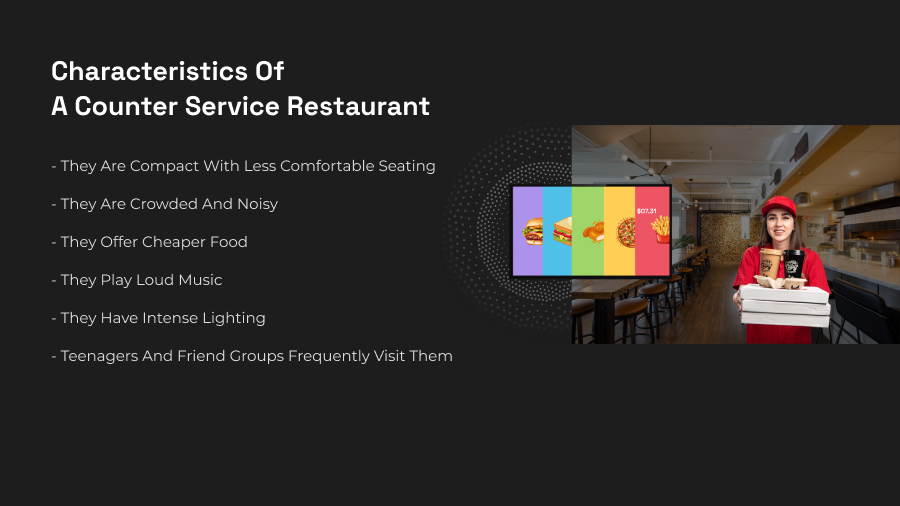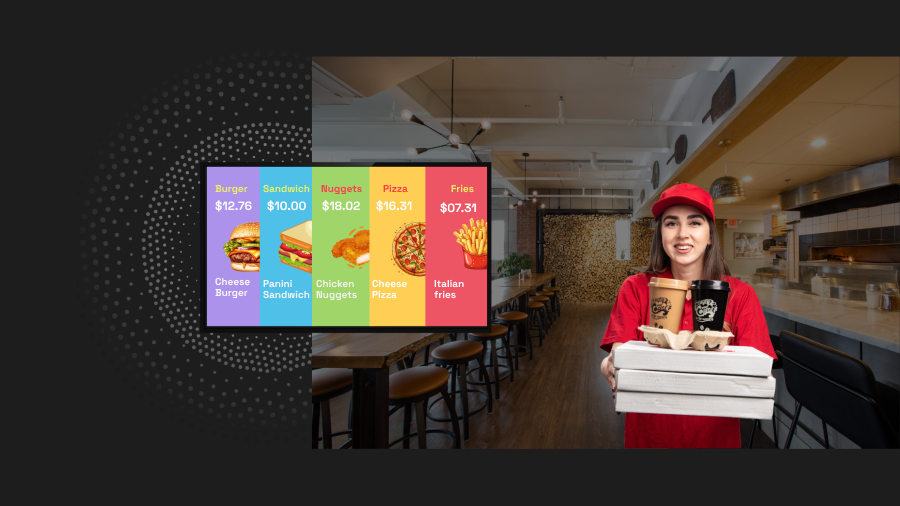What is Counter Service Restaurant
If you are a part of the hospitality sector, specifically the restaurant industry, you are sure to have considered the prospect of opening a restaurant in the counter service model. This thought of a counter service restaurant would have struck you while facing staff shortages on a busy weekend night or seeing long queues of customers waiting to find a table during weekdays. This is because a counter service restaurant model is a great way to achieve efficiency and profitability in the restaurant business.
The decision about selecting a restaurant model should be made based on the overall style of your restaurant operations, what you are offering for diners and the overall goals.
Before delving deeper into the topic, you must understand that the counter service model does not suit all types of restaurants. Restaurants that adopt this model have experienced a downfall in cost of food, quality and customer experience. This blog will help you understand what a counter service model is, what it means for your business and the right way to implement it for success.
A counter service restaurant is one in which customers place food orders, make payments for it and pick it up from the very same counter. Food may be prepared in the same location or be brought from some other place. Such counter service restaurants take the form of fast-food establishments, cafeterias and coffee shops.

Characteristics Of A Counter Service Restaurant
- They are compact with less comfortable seating
- They are crowded and noisy
- They offer cheaper food
- They play loud music
- They have intense lighting
- Teenagers and friend groups frequently visit them
- They have bold interiors like red and yellow
- They contain many vibrant wall arts and pictures
- Food is delivered within 15 minutes
- Food is served in non-reusable products
- They have one type of menu or a single cuisine type to offer
Difference Between Counter Service Restaurant & Table Service
As mentioned above, a counter service is a restaurant model in which guests play a more active role in the dining experience. This is because they place their food order at the counter, pay in advance, wait for their order to be prepared and receive the order to be either consumed at the same location or taken away.

Table service is available in a full-service restaurant. Guests walk into the restaurant, get seated at their respective table, given a menu and wait for a server to take their order. Shortly after they are served drinks, food is brought to their table. A server is available to check on the table very often. This ensures that the diner has a pleasant guest experience. Once the customer completes the meal, the check is brought to the table, the payment is processed, and the receipt handed over. Therefore, it involves a more hands-on experience than counter service as the latter is prominently a self-service model.
Since the role of a customer is more active in a counter service model, it is necessary to comply with the Americans with Disabilities Act (ADA). This is to ensure that the outlet is accessible to all customers in terms of entry, mobility and uninterrupted access to goods and services.
Ways To Comply With The ADA
Food ordering counters should not exceed a height of 36 inches or have a separate counter for passing over food to customers who face difficulty in reaching over.
The height of tables must remain between 28 to 34 inches.
By being inclusive and considerate of everyone’s needs, you will enjoy greater footfall with higher chances of people returning to you for more.
Advantages Of Opting For Counter Service
The following are the three major advantages of using the counter service model for your restaurant.
1) Low Labor Costs
Restaurateurs are sure to get excited every time someone talks about lowering operational costs in a restaurant. The major benefit of choosing a counter service model for the restaurant is that it helps lower labor costs. This model requires only minimal staff as people are not required to supervise the floor, cater to the needs of the guests, take orders, run dishes or perform any other kind of in-venue service. By setting up a self-ordering kiosk, one can leverage restaurant technology and reduce the requirement for staff. Guests place their orders and pay for the meal on their own, thus reducing the need for more staff. This is a win-win situation for both restaurant owners and customers.
2) Faster Service
There are instances when guests are in a hurry and are looking for a quick and convenient meal. During such times, they look for outlets with a counter service as they can walk up to the counter, place their order and receive it quickly with minimal interaction with the staff. This model is a convenient solution for guests seeking faster service. Using mobile POS systems can bust lines quickly as the kitchen is instantly updated with the orders facilitating faster preparation.
3) Better Upselling Opportunities
Counter service restaurants enjoy the advantage of increased sales due to easy upselling opportunities. The staff at the counter can ask the customer if they wish to upgrade their meal to a combo. Guests visiting a counter service restaurant are more likely to oblige and mcoake impulse decisions as they are in short of time. It is a win-win situation for both the business and the guest. This is not possible in a table service restaurant as the guests are at leisure and have ample time to think before deciding. This model permits the display of signage or digital displays at the counter where orders are placed, thus encouraging guests to order more or upgrade their meal.
Disadvantages Of A Counter Service Model Restaurant
1) Less Personal Dining Experience
The lack of ability to provide a personalized dining experience is a major drawback of this restaurant model. This is because of the guests’ fewer interactions with staff. Since the goal of a counter service restaurant is speed and efficiency, staff cannot create a personal connection with every guest who walks into the restaurant.
2) Limited Menu Options
The menu is always kept simple to make execution easy. A complex menu makes it difficult for back-of-house staff to complete orders as quickly as needed. If you do insist on following a complex menu offering a wide variety of ingredients and time-consuming recipes, then you must plan meticulously.
3) Smaller Check Sizes
The menu items of a full-service restaurant tend to be more expensive. The payment must be made along with a tip for the server. Also, alcohol is served in a table service restaurant, adding to the check size. On the other hand, in a counter service restaurant, the menu items are cheaper, customers are not required to pay any tips and alcohol is not served. This results in smaller check sizes when compared to counter service restaurants.
Things You Must Know About A Counter Service Restaurant Model
Using a counter service model comes along with a few hidden aspects that a restaurant owner must not overlook. Since these aspects could create a significant impact on the overall success and sustainability of the business in the long run, it is important to identify, understand and find ways to mitigate them.
Effect On Food Quality
If you were to survey people who eat at restaurants to think about the last time they had a fine-dining experience, they are unlikely to tell you about the food or ambiance of a counter service model restaurant. This is because customers tend to associate this model with lower-quality food unlike a high-quality kitchen.
When you opt for a counter service, the chefs of the restaurant must fulfill a high volume of orders over a short time. The need for speedy service could easily lead to a decrease in food quality if you are not cautious.
The best way to deal with this is to provide a smaller menu that has dishes that can be cooked to perfection in a quick manner. Counter service restaurants must learn to find a balance between service efficiency and food quality.
Customer Comfort
The counter service model can be convenient for customers in several situations. They might be rushing home or for any other appointment and therefore, might look to grab a bite before they get busy. But, even during such a brief and quick encounter with a restaurant, customers expect it to be engaging. Waiter service and QR code menus are a great way to increase customer comfort.
Food Prices
When you opt for a counter service model, you will automatically start competing with fast-food restaurants. But they will always be able to beat a counter service model restaurant with their price. So, you must offer greater quality food. If you fail to do so, customers looking for a quick meal are likely to choose a fast-food restaurant instead of you.
Customer Engagement
Restaurants of all types must engage in honest efforts to create and foster connections with their customers. A counter service model does not provide many opportunities for customers to interact with the team. But you can stay active online and enable customers to reach you via online forums. Social media and review platforms help customers understand that even if they do not get chances for interaction inside the restaurant, you still care about providing outstanding customer service.
Staff Job Satisfaction
If you are switching to a counter service restaurant model, it is likely to affect the employees. The number of staff must be brought up during the switchover. And you will need exactly the right people for the job. Make use of software to manage your human resources and train them well. Through this, they can respond quickly and efficiently to customers’ queries. The staff you are going to hire or retain must be satisfied with their job so that they stick around and perform well. Employees of a counter service restaurant must be offered quality benefits and several opportunities for learning and development.
With the information provided in this blog, you are now fully equipped to decide whether or not to opt for a counter service restaurant model. For more assistance in restaurant website building and restaurant digital marketing, get in touch.
KEY TAKEAWAY!

